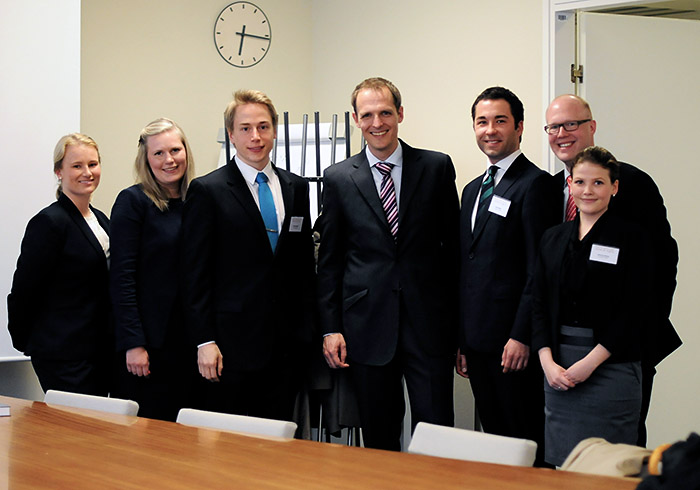Dean Kimmo Nuotio recently said in an interview that Moot Court competitions are one of the reasons for the increased international recognition of the Helsinki Law faculty. In addition to pedagogical advantages this is an obvious motivator for choosing moot courts as a strategic focal point for the faculty.
International visibility and pedagogic advantages are not the only arguments for moot courts from the university management perspective. When marketing moot courts courses for students one of the important selling points is the contacts that can be established not only with other students but also with professional circles in the field of law in question and in other universities. In my opinion networking and cooperation opportunities should also be understood and used at the institutional level.
Nowadays, all universities are involved in different forms of international cooperation. Let’s start with the number one task of research universities. In research most projects are international with international partners, publication, discussion and auditorium systems for the results. So cooperation in the area of research is a must and much attention is paid to it. The second main task of universities is teaching. Exchange programmes allow students to study one or two semesters in another country. Some universities, including Helsinki, also offer a master’s programme for students with a degree from another university. In addition, there are some teacher exchange programmes. To support the research and teaching interaction there are also administrative contacts between universities. Parallel to official university cooperation, different student organisations work together with similar associations abroad.
However, the different forms of cooperation between universities are often not connected. I believe linking the different ways of working together could strengthen the institutional connections and make cooperation easier and more rewarding. I believe moot courts courses could serve as the up till now missing link.
My experience in moot courts competitions is from the Vis Moot (Willem C. Vis International Commercial Arbitration Moot). The fields of law in Vis Moot are international arbitration and international commercial law. At least judging by the number of students participating in the oral finals of Vis Moot (Vienna) and Vis East (Hong Kong) it is the biggest moot court competition in the world.

Traditionally, the Vis Moot team of Helsinki University participates in the Vis Moot School of Switzerland, a preparatory course organised by the University of Zurich. In 2014 the coordinating teacher Santtu Turunen and the team arranged an info session about the Helsinki Pre-Moot 2015 for the 15 participating teams. In addition to the Pre-Moot, these students were also informed of the related seminar organised by YACF (Young Arbitration Club Finland) at the University of Helsinki in cooperation with the Pre-Moot organising law firms and given some promotional material about Finland.
In Vis Moot international cooperation between universities consists of participating in pre-moots (practice rounds often organised by universities, arbitral institutions or law firms) with other universities, practising pleadings in teleconferences, students sharing learning experiences in social media and joining preparatory courses, in our case the Vis Moot School of Switzerland organized by the University of Zurich. Also, the Vis Moot team of the faculty is mostly international, consisting of both Finnish law students, exchange students and master’s programme students. In addition to teaching-related cooperation, it is common to organise seminars on the fields of law in question in moot-related events and arrange guest lectures by members of the Vis Moot community. Vis Moot has also been used in Helsinki as a way of creating teaching cooperation with existing research partners. Student cooperation in the Vis Moot context is about learning together and sharing the learning experience, as well as making valuable contacts and friends of course.

In June 2014 the director of the Vis East competition, Louise Barrington, gave a guest lecture on professional ethics in international commercial arbitration. The lecture was commented on by Patricia Shaughnessy, who is the director of the ICAL programme and coordinating teacher of the Vis Moot course at the Stockholm University. The lecture was attended by researchers at the University of Helsinki, law students at the faculty, including exchange students and master’s students, young lawyers from various parts of Europe participating in another arbitration event in Helsinki and lawyers from the arbitration community in Helsinki. After the lecture Louise Barrington and Patricia Shaughnessy joined the info session about next year’s moot project.
In addition to inter-university cooperation, Vis Moot also serves as a media for alumni cooperation. I believe that it is crucial that alumni cooperation is not just about social events and fund raising but rather something with a close contentual link to what is actually being done universities. In Helsinki the Vis Moot team, in addition to the actual coaching team, is also supported by an active alumni community, consisting partly of alumni mooties still finishing their studies and partly of lawyers who have been practising for ten or more years. The international alumni community also gets together in the pre-mooting rounds, seminars and the oral parts of the competitions to jointly pass on something to the next generations.
I hope that the experiences of Vis Moot in terms of international and alumni cooperation can be of some use and inspiration for other moot court projects as well. As a teacher I consider mooting to be probably the best way to teach law, but since much effort and ample resources are needed to make the projects work it is also important to understand the additional gains that make the investments even more worthwhile for the faculties and people involved.
Santtu Turunen
research fellow, University of Helsinki
coordinating teacher of the Vis Moot course at University of Helsinki

